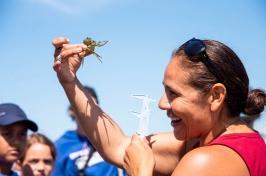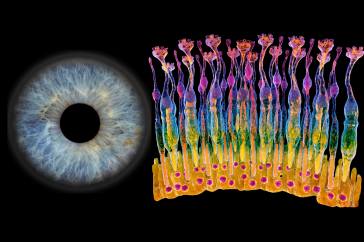
Mechanosensory hairs around the mouth of the Asian longhorned tick, seen here magnified 400 times, are what tipped off UNH experts to the arachnid's identity.
New Hampshire residents are no strangers to the threat posed by ticks. It’s likely that’s the reason a vigilant woman in Rindge, New Hampshire, recently sent an unusual tick, which she discovered on the dog of a friend visiting from upstate New York, to the UNH Insect Identification Center. Istvan Miko, the manager of the UNH Collection of Insects and Other Arthropods, identified the arachnid as the Asian longhorned tick — an invasive pest never before seen in the state.
Miko examined the mechanosensory hairs around the mouth and compared the specimen to two native species of Haemaphysalis ticks from UNH’s collection. Colleague Anna Wallingford, the state specialist in entomology and integrated pest management at UNH Cooperative Extension, agreed with his assessment.
“The ability to identify invasive, nonnative insects like the Asian longhorned tick is extremely important because their arrival has potentially important ecological implications for the state.”
“The ability to identify invasive, nonnative insects like the Asian longhorned tick is extremely important because their arrival has potentially important ecological implications for the state,” says Miko. “It was terrific to be able to work with the NH Department of Agriculture, Markets and Food (NHDAMF) and draw on the significant resources of the university to quickly and accurately ID the tick.”
The U.S. Department of Agriculture National Veterinary Services Laboratory confirmed the identification of the Asian longhorned tick, or Haemaphysalis longicornis, using molecular techniques.
Although it’s not clear whether the tick was merely an unwitting travel companion, state officials are asking New Hampshire residents to be alert for the presence of any ticks on themselves, family members and their pets.
Nate Bernitz, who runs Extension’s Infoline in Goffstown, also provided information to the reporting resident regarding precautions she should take to ensure the dog didn’t leave behind any additional ticks in her home.
The tick, which is native to Southeast Asia, has been identified in nine states since late 2017, and has been found on sheep, goats, dogs, cats, horses, cattle, deer, opossums, raccoons and humans, but has not been linked to the spread of any disease. But in other parts of the world, the tick is a vector for diseases including anaplasmosis and babesiosis, which are spread in New Hampshire by deer ticks.
People should use typical tick-avoidance strategies for themselves and the animals in their care – wear appropriate clothing, use insecticides and conduct tick checks regularly. Any unusual ticks should be submitted for identification through either a veterinarian or physician to the NH Department of Agriculture, Markets, and Food.
The NHDAMF says the public’s assistance in monitoring ticks is essential because the state does not currently have the ability to perform routine tick surveillance.
“Without the initial and correct identification by UNH personnel and the UNH Extension’s insect identification outreach to the people of the state, this infestation may well have been more widely spread beyond the single site from which it is now known,” says Don Chandler, professor in the department of biological sciences.
-
Written By:
Sarah Schaier | College of Life Sciences and Agriculture





















































